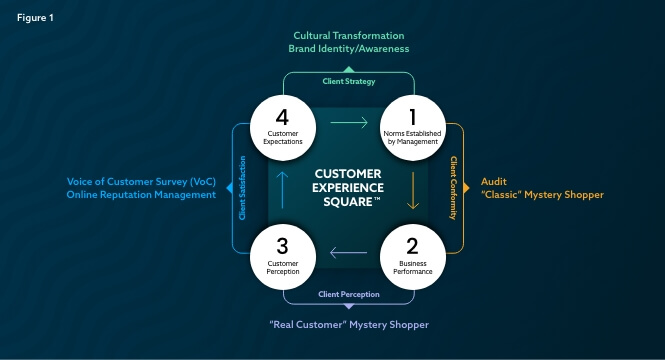The Customer Experience Square: How Does It Work?
Measuring Client Conformity
Client Conformity is defined by assessing the gap between the standards set by a company’s management (established norms) and the actual performance of its staff (the service delivered by employees).
This type of measurement typically consists of a smaller number of evaluations but includes numerous criteria, ensuring that employees adhere to company procedures and service standards. Our classic mystery shopping programs (conducted without employees’ knowledge) and audits (announced to staff) are both forms of compliance measurement.
(See Figure 1: Gap between #1 and #2).
Measuring Client Perception
It is well known that what truly matters is not just what a company does for its customers, but how customers perceive those efforts. Client Perception measurement focuses on evaluating the gap between employee performance and the customers’ perception of the service they receive.
With shorter surveys and a higher volume of evaluations compared to compliance measurement, this approach helps identify “moments of truth”—the aspects of service that matter most to customers. Invest your efforts where they truly make a difference! Our “real customer” mystery shopping programs are ideal for this type of measurement.
(See Figure 1: Gap between #2 and #3).
Measuring Client Satisfaction
Client satisfaction is determined by evaluating the gap between customer perception and customer expectations—the anticipated standards they have before interacting with a company.
The preferred method here is typically continuous surveys, known as “Voice of Customer” (VoC). These surveys assess the emotional dimension of the customer experience. With very short questionnaires and a much larger volume of responses per service point, this type of measurement is highly proactive. It allows businesses to react quickly to dissatisfaction, preventing negative repercussions on social media or through word-of-mouth.
(See Figure 1: Gap between #3 and #4).
Client Strategy
To “close the loop,” Client Strategy involves measuring the gap between customer expectations and the standards set by management.
For example, surveys or semi-structured interviews assessing brand perception and customer expectations can help adjust service standards to align perfectly with what customers anticipate—hence the concept of the Customer Experience Square. This iterative process ensures that service standards evolve alongside changing customer expectations, driving continuous improvement in the customer experience.
(See Figure 1: Gap between #4 and #1).


















